Following Van Gogh
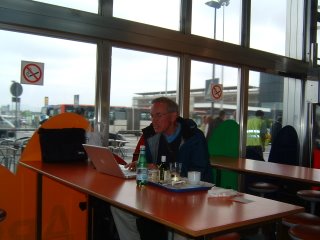
Todd v. Technology
Technical Note: You may have noticed in previous postings that our text occasionally refers to a photo that does not appear. The reason is that photo-uploading at this site is a strange and mysterious process that we have clearly not mastered. When a photo is omitted from an uploaded group, we can neither understand the reason nor upload it separately. If anyone can offer pertinent advice, we would be very grateful.
Southern France, April 29-May 1
Leaving Zermatt, we eschewed the tollway in favor of a spectacular drive on a two-lane road around the slopes of Mont Blanc via the Mer de Glace and Chamonix until we reached Albertville. Then we proceeded on France’s high-speed (130 km/hr) but expensive autoroute to Avignon, where we stayed for two nights.
The chief attraction of this town is the Palais des Papes, which was the seat of the Roman Catholic Church between 1309 and 1377, and some subsequent periods, because of political-military turmoil in Rome and the desire of the French monarchy to control the Papacy. What came as surprise to us was the immensity of the palace (actually two adjoining palaces, each built by a different pope), which contains an enormous chapel and large halls for consistories and other meetings. The scale is somewhat smaller, we suppose, than that of the Vatican complex in Rome but extraordinarily impressive in view of the peculiar circumstances in which the popes found themselves during this period.
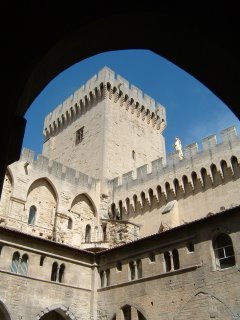
Palais des Papes
Of course, no visit to Avignon would be complete without a visit to the famous bridge, on which “l’on y danse, tout en ronde.” A sign explained, however, that the song originated from the prior existence of a tavern on an island UNDER the bridge, where there was indeed much singing and dancing. Then somewhere along the line “sous le pont” became “sur le pont,” presumably because it made more sense to people unfamiliar with the Avignon scene. The tavern is now long gone, but the bridge boasts not one, but two chapels, which were fortunately not on the section that was swept away by a flood in the 17th Century, never to be replaced.
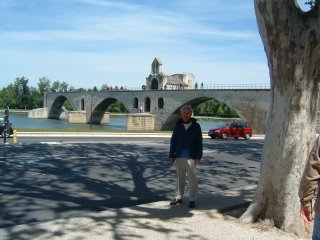
Pont d'Avignon
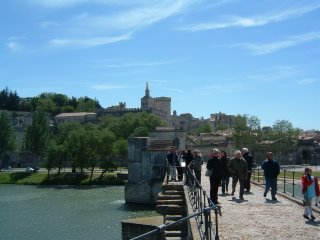
Palais des Papes from Pont d'Avignon
We next drove to Nimes, to see the Maison Carrée, an amazingly well preserved Roman temple dating from the reign of Augustus. This structure has special significance for Todd, for the architect of IIE’s new headquarters used a photograph of the temple and the contemporary building next door, designed by an internationally renowned British architect, to justify to DC officialdom the placement of a modern building on fusty Massachusetts Avenue. A visit to the Roman arena in Arles, also well preserved, completed our visit to the region.
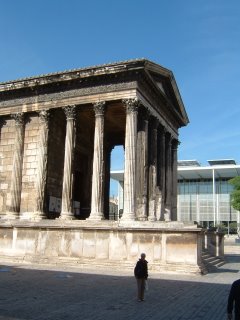
Maison Carrée
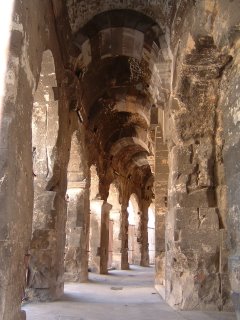
Arena in Arles
The landscape around Nimes is immediately recognizable from Van Gogh paintings. However, the Mistral was blowing so hard during most of our stay in southern France that we wondered how Vincent could have held on to his palette.
Our last stop in France was Carcassonne, which features a wonderfully fortified inner city, built successively by Gallo-Romans, Visigoths, local counts, and French kings, whose impressive battlements are still intact. This is a place that Todd had wanted to visit since seeing pictures and reading a description of it in Richard Halliburton’s “Book of Marvels” when he was nine or so. It certainly did not disappoint. However, despite its well-designed fortifications, the citadel fell to crusaders in 1209 after only a two-week siege, reportedly because the defenders failed to supply themselves with enough water. (An earlier example of poor military planning?) Today it includes a basilica, which marries Romanesque and Gothic styles, and some excellent restaurants, including the “Auberge de Dame Carcas,” where we had a delicious (and surprisingly inexpensive) cassoulet dinner.
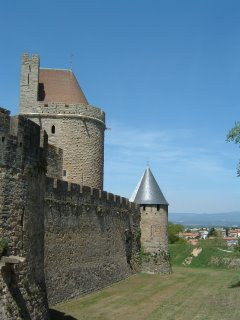
Carcassonne

Our Carcassonne Restaurant

0 Comments:
Post a Comment
<< Home